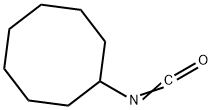Isopropyl isocyanate
- CAS NO.:1795-48-8
- Empirical Formula: C4H7NO
- Molecular Weight: 85.1
- MDL number: MFCD00002037
- EINECS: 217-276-5
- SAFETY DATA SHEET (SDS)
- Update Date: 2025-09-25 17:15:13

What is Isopropyl isocyanate?
Chemical properties
Colorless liquid
The Uses of Isopropyl isocyanate
Isopropyl isocyanate is used as a reagent in the preparation of androgen receptor antagonist for prostate cancer treatment. It is also used in the synthesis of selective dual inhibitor of mammalian target of rapamycin (mTORC1 and mTORC2). Further, it serves as a reagent in the synthesis of O-aryl N-isopropylcarbamates. In addition to this, it is used as a derivatization reagent during the stereoisomeric analysis of secondary alcohols.
General Description
A colorless liquid with a pungent odor. Insoluble in water. Flash point near 60°F. Very toxic by ingestion and inhalation. Vapors are heavier than air. Used to make other chemicals.
Air & Water Reactions
Highly flammable. Insoluble in water.
Reactivity Profile
Isocyanates and thioisocyanates, such as Isopropyl isocyanate, are incompatible with many classes of compounds, reacting exothermically to release toxic gases. Reactions with amines, aldehydes, alcohols, alkali metals, ketones, mercaptans, strong oxidizers, hydrides, phenols, and peroxides can cause vigorous releases of heat. Acids and bases initiate polymerization reactions in these materials. Some isocyanates react with water to form amines and liberate carbon dioxide. Base-catalysed reactions of isocyanates with alcohols should be carried out in inert solvents. Such reactions in the absence of solvents often occur with explosive violence, [Wischmeyer(1969)].
Health Hazard
TOXIC; inhalation, ingestion or contact (skin, eyes) with vapors, dusts or substance may cause severe injury, burns or death. Bromoacetates and chloroacetates are extremely irritating/lachrymators. Reaction with water or moist air will release toxic, corrosive or flammable gases. Reaction with water may generate much heat that will increase the concentration of fumes in the air. Fire will produce irritating, corrosive and/or toxic gases. Runoff from fire control or dilution water may be corrosive and/or toxic and cause pollution.
Fire Hazard
HIGHLY FLAMMABLE: Will be easily ignited by heat, sparks or flames. Vapors form explosive mixtures with air: indoors, outdoors and sewers explosion hazards. Most vapors are heavier than air. They will spread along ground and collect in low or confined areas (sewers, basements, tanks). Vapors may travel to source of ignition and flash back. Substance will react with water (some violently) releasing flammable, toxic or corrosive gases and runoff. Contact with metals may evolve flammable hydrogen gas. Containers may explode when heated or if contaminated with water.
Properties of Isopropyl isocyanate
| Melting point: | <-75℃ |
| Boiling point: | 74-75 °C(lit.) |
| Density | 0.866 g/mL at 25 °C(lit.) |
| refractive index | n |
| Flash point: | 27 °F |
| storage temp. | 2-8°C |
| solubility | Chloroform (Soluble), Ethyl Acetate |
| form | Oil |
| color | Colourless |
| Water Solubility | Insoluble |
| Sensitive | Moisture Sensitive |
| BRN | 969356 |
| Stability: | Hygroscopic, Light Sensitive, Moisture Sensitive, Volatile |
| CAS DataBase Reference | 1795-48-8(CAS DataBase Reference) |
| EPA Substance Registry System | Propane, 2-isocyanato- (1795-48-8) |
Safety information for Isopropyl isocyanate
| Signal word | Danger |
| Pictogram(s) |
 Flame Flammables GHS02  Skull and Crossbones Acute Toxicity GHS06  Health Hazard GHS08 |
| GHS Hazard Statements |
H225:Flammable liquids H315:Skin corrosion/irritation H317:Sensitisation, Skin H319:Serious eye damage/eye irritation H330:Acute toxicity,inhalation H334:Sensitisation, respiratory H335:Specific target organ toxicity, single exposure;Respiratory tract irritation |
| Precautionary Statement Codes |
P210:Keep away from heat/sparks/open flames/hot surfaces. — No smoking. P233:Keep container tightly closed. P280:Wear protective gloves/protective clothing/eye protection/face protection. P303+P361+P353:IF ON SKIN (or hair): Remove/Take off Immediately all contaminated clothing. Rinse SKIN with water/shower. P305+P351+P338:IF IN EYES: Rinse cautiously with water for several minutes. Remove contact lenses, if present and easy to do. Continuerinsing. |
Computed Descriptors for Isopropyl isocyanate
Isopropyl isocyanate manufacturer
ASM Organics
New Products
Indole Methyl Resin tert-butyl 9-methoxy-3-azaspiro[5.5]undecane-3-carboxylate Boc-His(Boc)-OH 2-CTC Resin 4-Chloro-7-tosy1-7Hpyrrolo[2,3-d]pyrimidine 5,7-Dibromo-1H-indole 2,5-dichloro-N-hydroxy-4,6-dimethylpyridine-3-carboximidamide 2,2-Dimethoxy-7-azaspiro[3.5]nonane hydrochloride 4-chloromethyl-5-methyl-1,3-dioxol-2-one (DMDO-Cl) R-2-BENZYLOXY PROPIONIC ACID 1,1’-CARBONYLDIIMIDAZOLE 1,1’-CARBONYLDI (1,2-4 TRIAZOLE) N-METHYL INDAZOLE-3-CARBOXYLIC ACID 4-((2-hydroxyethyl)thio)benzoic acid 1-(TERT-BUTOXYCARBONYL)-2-PYRROLIDINONE Methyl 6-methylnicotinate 3-Pyridineacrylic acid tert-Butyl carbazate TETRAHYDRO-2H-PYRAN-3-OL 2-((4-morpholinophenylamino) (methylthio) methylene) malononitrile 3-(4-morpholinophenylamino)-5-amino-1H-pyrazole-4-carbonitrile 2,4-dihydroxybenzaldehyde 1,3-Diethyl-1,3-Diphenylurea Methyl 2-methylquinoline-6-carboxylateRelated products of tetrahydrofuran








You may like
-
 1795-48-8 Isopropyl isocyanate 98%View Details
1795-48-8 Isopropyl isocyanate 98%View Details
1795-48-8 -
 Isopropyl isocyanate CAS 1795-48-8View Details
Isopropyl isocyanate CAS 1795-48-8View Details
1795-48-8 -
 Iso Propyl Iso CyanateView Details
Iso Propyl Iso CyanateView Details
1795-48-8 -
 IsopropylisocyanateView Details
IsopropylisocyanateView Details
1795-48-8 -
 Isopropyl IsocyanateView Details
Isopropyl IsocyanateView Details
1795-48-8 -
 Pyridine 99.5% HPLC /UV SpectroscopyView Details
Pyridine 99.5% HPLC /UV SpectroscopyView Details
110-86-1 -
 Dibutyl PhthalateView Details
Dibutyl PhthalateView Details
84-74-2 -
 Thiourea 99% ARView Details
Thiourea 99% ARView Details
62-56-6
